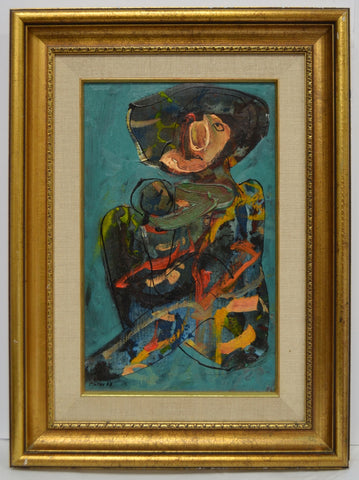Many art experts are of the view that Putov was a Master expressionist painter and as such, deserves more international recognition than he has yet garnered. We couldn't agree more.
Alexandre Sacha Putov (1940-2008) was born near Rostov in the Soviet Union, became an Israeli citizen and spent the most productive years of his artistic career in Paris, France. Although his work varied greatly over his 30-year career he is generally recognized as an expressionist painter. Some of his work is figurative but many works are highly abstracted and impressionist representations of his subjects.
Putov was an architect by training. He studied under Michael Schwartzman, a renowned Russian painter. He was not part of the state-sponsored art scene under the Soviet regime, so much of what Putov produced during his time there was left in the Soviet Union and likely lost after he moved to Israel in 1973. He later moved to Paris in 1980 and became a member of the "Art Cloche" group. Alexandre Putov was first and foremost an expressionist painter, influenced greatly by Russian avant-garde and French Impressionists. Some of his greatest influences were Van Gogh, Chagall and Kandinsky. Putov is most widely appreciated in France, Canada and Israel.
Although Putov created some quality cityscapes, we believe that Putov’s greatest works were his portraits and still-lifes and these are the pieces that we have focused on collecting over the years.
Putov masterpieces currently available from The Langford Gallery Collection:

Mother and Child is an important subject in Putov’s body of work. This small oil painting is beautifully composed and imaginative. Mother and Child is both vivid and generous and very emotionally expressive because of Putov’s use of colour. He used the 3 primary colours – blue, yellow and red to unite this painting. This abstracted impressionist-expressionist painting is one of Putov’s best and most delicate works of art. Oil on canvas. Paris, 1993.

Portrait of Woman with Mask is interesting in that Putov provides commentary on this woman by painting her with a mask covering most of her face. The abstract background is dominated by reds and blues. Putov has painted this portrait such that the background extends into the figure. His painting style conveys action/tension consistent with his feelings about this woman in his life. Oil on canvas. Paris, est. 1990's.

Nude Woman on Pink is unique in that Putov did not commonly paint nudes. The nude is minimally sculpted in lyrically drawn white and black lines over top of an abstracted background of pink and green (and some red). In many ways this portrait is one of Putov’s “prettiest’ and most aesthetic works of art.

Four Faces. This painting of four figures is characterized by the contrast between the blue background and the gold and reds of the bodies of the figures. In this rendering Putov uses white rather than his normal black to trace outlines of his figures and faces. Acrylic on paper. Paris, 1990's.
Three Faces is one of Putov’s brightest paintings. The three figures would have been family or friends. In this painting Putov used yellow and blue (yellow-blue) and orange (yellow-red) for his background. The three figures are drawn more figuratively than the vast majority of Putov’s works. Water colour and pen on paper, 1993.

Two Women with Child represents a mother with a young child standing with another women reacting to the child. The child is central to this work and represents some of Putov’s views on the relationship of mother to her child. In this rendering Putov uses black to trace outlines of his figures and faces on an abstracted background of pink. Acrylic paint and pen on paper. Paris, 1985.
Please visit our Paintings and Prints Collection for more information.



Comments on post (0)
Leave a comment